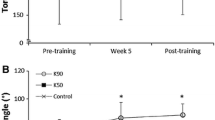Abstract.
The influence of muscle series elasticity on the relationship between torque and joint angle during dynamic contractions was studied. The torque–angle relationship during the maximal isokinetic knee extension was determined for six male subjects (25–45 years) at 0.52, 1.05, 1.57, 2.09, 2.62, 3.49 rad/s. The knee joint angle at which peak torque was observed showed a systematic shift to more extended positions, i.e., the quadriceps muscle–tendon unit length became shorter as the velocity increased [from 1.01 (0.12) rad (0.52 rad/s) to 0.75 (0.14) rad (3.49 rad/s), mean (SD)]. The corresponding difference in muscle–tendon unit length between 0.52 and 3.49 rad/s, estimated from the angle shift at peak torque and the moment arm length change of the quadriceps muscles, was 9 (4) mm. The relationship between estimated changes in muscle–tendon unit length and muscle force of the vastus lateralis and intermedius (VLI) over the seven velocities (including isometric contraction, 0 rad/s) coincided with the load-elongation properties of the series elastic component of VLI, determined separately in vivo by ultrasonography when the same subjects performed a ramp isometric knee extension. The results suggest that the torque–angle relationship is affected by the interaction between contractile and elastic components, and that peak torque angle shift is attributable to the elongation of tendinous tissues as a function of force applied to them.
Similar content being viewed by others
Author information
Authors and Affiliations
Additional information
Electronic Publication
Rights and permissions
About this article
Cite this article
Kawakami, .Y., Kubo, .K., Kanehisa, .H. et al. Effect of series elasticity on isokinetic torque–angle relationship in humans. Eur J Appl Physiol 87, 381–387 (2002). https://doi.org/10.1007/s00421-002-0657-6
Accepted:
Issue Date:
DOI: https://doi.org/10.1007/s00421-002-0657-6




